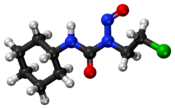Lomustine
 | |
 | |
| Clinical data | |
|---|---|
| Trade names | Gleostine |
| Synonyms | 1-(2-chloroethyl)-3-cyclohexyl-1-nitrosourea |
| AHFS/Drugs.com | Monograph |
| MedlinePlus | a682207 |
| Pregnancy category | |
| Routes of administration | Oral (capsules) |
| ATC code | |
| Legal status | |
| Legal status | |
| Pharmacokinetic data | |
| Bioavailability | ~100% |
| Protein binding | 50% |
| Metabolism | Liver |
| Metabolites | Monoxydroxylated metabolites, trans-4-hydroxy-CCNU, cis-4-hydroxy-CCNU[1] |
| Elimination half-life | 16–48 hours (metabolites) |
| Identifiers | |
| |
| CAS Number | |
| PubChem CID | |
| IUPHAR/BPS | |
| DrugBank | |
| ChemSpider | |
| UNII | |
| KEGG | |
| ChEBI | |
| ChEMBL | |
| ECHA InfoCard |
100.032.585 |
| Chemical and physical data | |
| Formula | C9H16ClN3O2 |
| Molar mass | 233.695 g/mol |
| 3D model (JSmol) | |
| Melting point | 90 °C (194 °F) |
| |
| |
| | |
Lomustine (INN), abbreviated as CCNU (original brand name (formerly available) is CeeNU, now marketed as Gleostine), is an alkylating nitrosourea compound used in chemotherapy. It is closely related to semustine and is in the same family as streptozotocin. It is a highly lipid-soluble drug,[2] thus it crosses the blood-brain barrier. This property makes it ideal for treating brain tumors, which is its primary use, although it is also used to treat Hodgkin lymphoma as a second-line option.[3] Lomustine has a long time to nadir (the time when white blood cells reach their lowest number).
Unlike carmustine, lomustine is administered orally. It is a monofunctional alkylating agent, alkylates both DNA and RNA, has the ability to cross-link DNA.[4] As with other nitrosoureas, it may also inhibit several key enzymatic processes by carbamoylation of amino acids in proteins.[5] Lomustine is cell-cycle nonspecific.
It has also been used in veterinary practice as a treatment for mast cell tumors in dogs.[6]
Price increase
In the U.S., the patent for lomustine has expired, but only one company manufactures it. In 2013, Bristol-Myers Squibb Co. sold its CeeNU brand of lomustine to CordenPharma, a subsidiary of International Chemical Investors S.E., which markets it as Gleostine through NextSource Biotechnology. In 2013, BMS charged $50 a capsule. In 2018, NextSource charged $768 a capsule. Some doctors said the price increase made it unaffordable, and one doctor called it "price gouging."[7][8][9]
References
- ↑ Lee, FY; Workman, P; Roberts, JT; Bleehen, NM (1985). "Clinical Pharmacokinetics of Oral CCNU (lomustine)". Cancer Chemotherapy and Pharmacology. 14 (2): 125–31. doi:10.1007/bf00434350. PMID 3971475.
- ↑ "BC Cancer Agency Cancer Drug Manual. Lomustine (CCNU; CeeNU)" (PDF). Retrieved 15 July 2016.
- ↑ "PRODUCT INFORMATION CeeNU®(lomustine)" (PDF). TGA eBusiness Services. Bristol-Myers Squibb Australia Pty Ltd. 30 September 2015. Retrieved 23 April 2018.
- ↑ Pizzo, PA; Poplack, DG, eds. (2006). Principles and Practice of Pediatric Oncology (5th ed.). Philadelphia: Lippincott Williams & Wilkins. p. 300. ISBN 9780781754927.
- ↑ "Gleostine (lomustine) Capsules, for Oral Use. Full Prescribing Information" (PDF). NextSource Biotechnology, LLC. Retrieved 15 July 2016.
- ↑ Weiss, Douglas J.; Wardrop, K. Jane; Weiss, Douglass (2010). Schalm's Veterinary Hematology (6 ed.). John Wiley & Sons, Incorporated. p. 487. ISBN 978-0-8138-0896-3.
- ↑ Cancer Drug Price Rises 1400% With No Generic to Challenge It, Peter Loftus, The Wall Street Journal, 12/26/2017 [FREE]
- ↑ "NextSource Biotechnology Gains FDA Approval for Use of Tradename Gleostine (lomustine), an Anti-Cancer Chemotherapy Agent". www.prnewswire.com. NextSource Biotechnology. Retrieved 15 July 2016.
- ↑ "Gleostine (lomustine) Capsules — Healthcare Providers". NextSource Biotechnology. Retrieved 15 July 2016.
External links
- CeeNu (lomustine) Capsules data sheet published by the FDA
- Lomustine at the US National Library of Medicine Medical Subject Headings (MeSH)
- DDB 29525